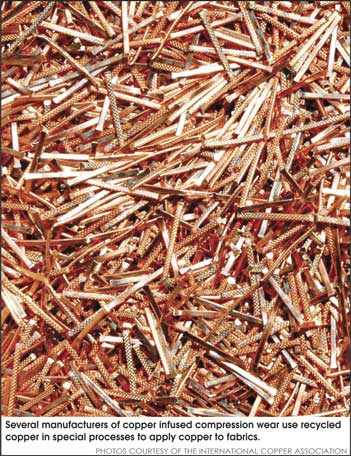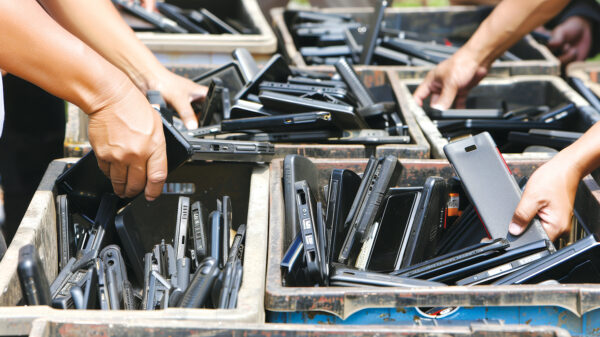by MIKE BRESLIN 
Over the past few years it seems that most every televised sporting event is interrupted by commercials proclaiming the benefits of copper infused clothing.
These TV spots are an apparent retirement fund for retired athletes who claim pain relief and improved physical performance from compression garments laced with copper fibers.
Since copper recovery is near and dear to the hearts and pocketbooks of many scrappers and recyclers, American Recycler News looked into the subject. Are these garments actually beneficial and what are the recycling implications? Here’s what we learned.
There seems to be a long tradition in alternative medicine saying that copper bracelets relieve arthritis. Some also believe that copper is absorbed through the skin or somehow creates a magnetic field, thereby treating tissue. Medical science has found that wearing copper has no known benefit for any medical condition, except for its proven antimicrobial properties for skin and surfaces in medical facilities such as hospitals. Being antimicrobial, copper destroys or inhibits the growth of microorganisms, especially pathogenic microorganisms.
The other claims often made for these copper laden garments are the added benefit of compression to provide pain relief and additional support, or bracing to body joints. It is true that compression clothing is an accepted medical treatment for some ailments such as high blood pressure where therapeutic compression stockings help prevent swelling in feet and legs. The claims that copper infused compression garments have therapeutic effects has yet to be proven. The addition of copper may have no benefit beyond a placebo effect.
Tommie Copper, Inc. one of the leading marketers of copper infused compression garments was contacted to learn about the technical details of their products which include compression sleeves, tops, bottoms, underwear and socks. They declined with the reply, “At this time, we cannot provide information or comments for your article.”
Shortly thereafter we learned that Tommie Copper is the subject of a class action lawsuit filed in the U.S. District Court for Southern District of New York against Tommie Copper Inc., alleging violations of New York’s Deceptive Trade Practices Law and Iowa’s Private Right of Action for Consumer Frauds Act, as well as breach of express warranty, negligent misrepresentation and unjust enrichment. Plaintiff claims that the defendant made false and misleading claims concerning the alleged skin and health benefits of its copper-infused athletic apparel, including the ability to provide relief from aches and pains and a faster recovery period. (Potzner, et al. v. Tommie Copper Inc., No. 15-cv-03183 (S.D.N.Y. complaint filed Apr. 22, 2015)).
The suit alleges that the company violated consumer protection laws by overstating the health benefits of its copper infused apparel. The class in this lawsuit includes any person who paid for any Tommie Copper garment that was advertised as containing copper in its fabric, prior to November 2014. The complaint alleges that Tommie Copper made the claims that its products rejuvenate and revive the body; relieve aches and pains; increase
oxygen transportation; improve muscle mobility and recovery; and that copper is absorbed by the body promoting better skin health and recovery time. The complaint alleges that none of these claims are true.
It is true that humans can have a copper deficiency in their diet, but it’s rare, because copper is present in many common foods. And there’s also no scientific evidence that copper can be absorbed through the skin.
 To get background on copper in compression fabrics we called on Scott R. Baker, PhD, and director of the health, environment and sustainable development program for the International Copper Association, the global association of the copper industry.
To get background on copper in compression fabrics we called on Scott R. Baker, PhD, and director of the health, environment and sustainable development program for the International Copper Association, the global association of the copper industry.
“How copper compression clothing uses copper comes from several years of applications of metals to fabrics with the marketing claim that these metals have antimicrobial properties and keep clothing from smelling and staining,” said Baker. “It began, I believe, with the silver industry several years ago claiming that there were beneficial properties in silver and stainless steel.
Baker said that about 10 years ago the copper industry discovered the very strong antimicrobial properties of copper. And, when they did the studies, it became very apparent that copper was a much more effective killer of microbes than any other product of any kind. In recent years, the copper industry launched a campaign in the hospital environment to employ copper on touch surfaces to keep surfaces cool and free of very virulent microbes to combat Hospital Acquired Infections (HAI). Copper has been shown effective in various demonstration cases done at hospitals with IV poles and other equipment made out of copper alloys. They proved to be much better than stainless steel that is being used.
“There is a history of metal applications in all types of materials including fabrics, Baker continued. “I think the origin of metals in fabrics arose in Japan when they began to make antimicrobial clothing because of their fetish with cleanliness. It soon migrated to other parts of the world. A few years ago, an enterprising company in Israel named Cupron developed a copper-based antimicrobial technology for a first-of-its-kind antifungal sock designed for foot care for people with diabetes.”
Cupron uses copper oxide powder made from natural, recycled copper which is combined with, for example, polyester to create small particles that can then be added to fibers (polyester, nylon, polypropylene) much like color or other additives. Their processes and applications are patented. These copper-infused fibers apparently have a positive effect on the diabetic foot, specifically an ability to kill athlete’s foot fungus.
Cupron cites over 30 studies of their products on its website, www.cupron.com. In one study of 56 patients with severe athlete’s foot, a significant improvement of the medical symptoms in all patients was seen within 9 days of wearing socks made with its fibers. They were found to kill 99.9 percent of athlete’s foot fungus on the sock. The sock also recently received approval from the EPA for its antifungal public health claim. The antifungal technology is embedded in the fibers of the sock, and as a result, Cupron claims the effectiveness will not diminish over time. The company is also marketing a pillowcase and other products that include its patented copper technology embedded in microfibers.
“The reason why Cupron persevered because they understood that diabetics and others people who have problems with wound healing would benefit from having copper socks because copper aids in wound healing,” Baker added. “After that and more recently people got the idea that copper could be used for other purposes. The business of copper infused compression fabrics is the most recent development. It’s a twist on the idea of antimicrobial, but some manufacturers of those products also claim that it also enhances performance. There is little if no scientific evidence to support those compression claims. It’s the same thing with people who wear copper bracelets, or copper infused golfing gloves. Some swear by them while others claim no effect, except turning the wrist green.
Baker believes that there is no bonafide scientific evidence of consistency, of repeatability and reproducibility that improved performance effects are actually caused by copper. He thinks the theory is because of copper’s ionic potential, its oxidation reduction potential, which makes it a really good conductor of electricity, that it has the same type of impact on the human body. Some manufacturers claim that the ionic contact produced through sweat and contact with the skin are having some type of stimulatory effect based on electrical properties that is enabling these beneficial functions. “It’s clearly true for the antimicrobial properties, but whether or not it’s true for pain therapy or strength conditioning, there’s not strong evidence to support it,” said Baker.
“Who knows if it’s virgin or recycled copper that manufacturers of infused compression wear are using? If it’s a thread, it’s probably a very fine wire. Most of the copper wire that is produced for electrical applications has to be ultra-pure because you can’t have any impurities that could cause hot spots and fire hazards. Building codes require it to be non-recycled or virgin copper. So it depends on where these compression fabrics manufacturers are sourcing their copper if it’s virgin or recycled. I have never heard of wire being manufactured that is not ultra pure. Wire and cable makers would not waste their time making unpure copper products.
Baker reported that at this time, the copper infused fabric market represents a very tiny but growing market share of copper consumption, an extremely low tonnage. Even though you see copper compression commercials on TV and they have respectable sales, the amount of copper in any one of these products is minuscule compared to the many other high-tonnage applications such as infrastructure.
“Our other concerns about copper infused fabrics are unintentional dispersions of copper into the environment,” Baker warned. “You don’t think about copper leaching off in the washing machine and stressing water treatment facilities with copper loading, which eventually winds up in the environmental pool. For that reason, the copper industry does not endorse those types of products. It makes very good sense for these copper fabric manufacturers to use recycled copper, but I don’t know where they source the product.
“At the end of its useful life, copper infused clothing, like any other product has to be disposed of. There’s no documentation of what people are doing with these used garments and they essentially become hazardous waste whether incinerated or buried in a landfill. There’s not enough tonnage of this fabric to be concerned about now, but it’s like throwing copper in the trash can. It’s still a useful product that can be recycled, but I don’t think the recycling infrastructure is there to capture it at end of useful life. Consumers will likely just throw it away, or give it to a charity like Salvation Army. And, what will they do with it?
“Copper prices are now in a trough, but that is true of all commodities. Copper tends to lead the commodities trades in the sense that if you look at copper prices and what they are doing month-to-month you can expect that other metals and commodities, whether pork bellies or corn for example, will follow. The markets are really tight right now because the price of copper is low, but it cycles. It always cycles. It’s very predicable that the price will rise over a period of time that usually lasts a few years. Our industry is used to weathering the storm and enjoying the sunshine at times of peaks,” Baker ended.
Published in the December 2015 Edition of American Recycler News







